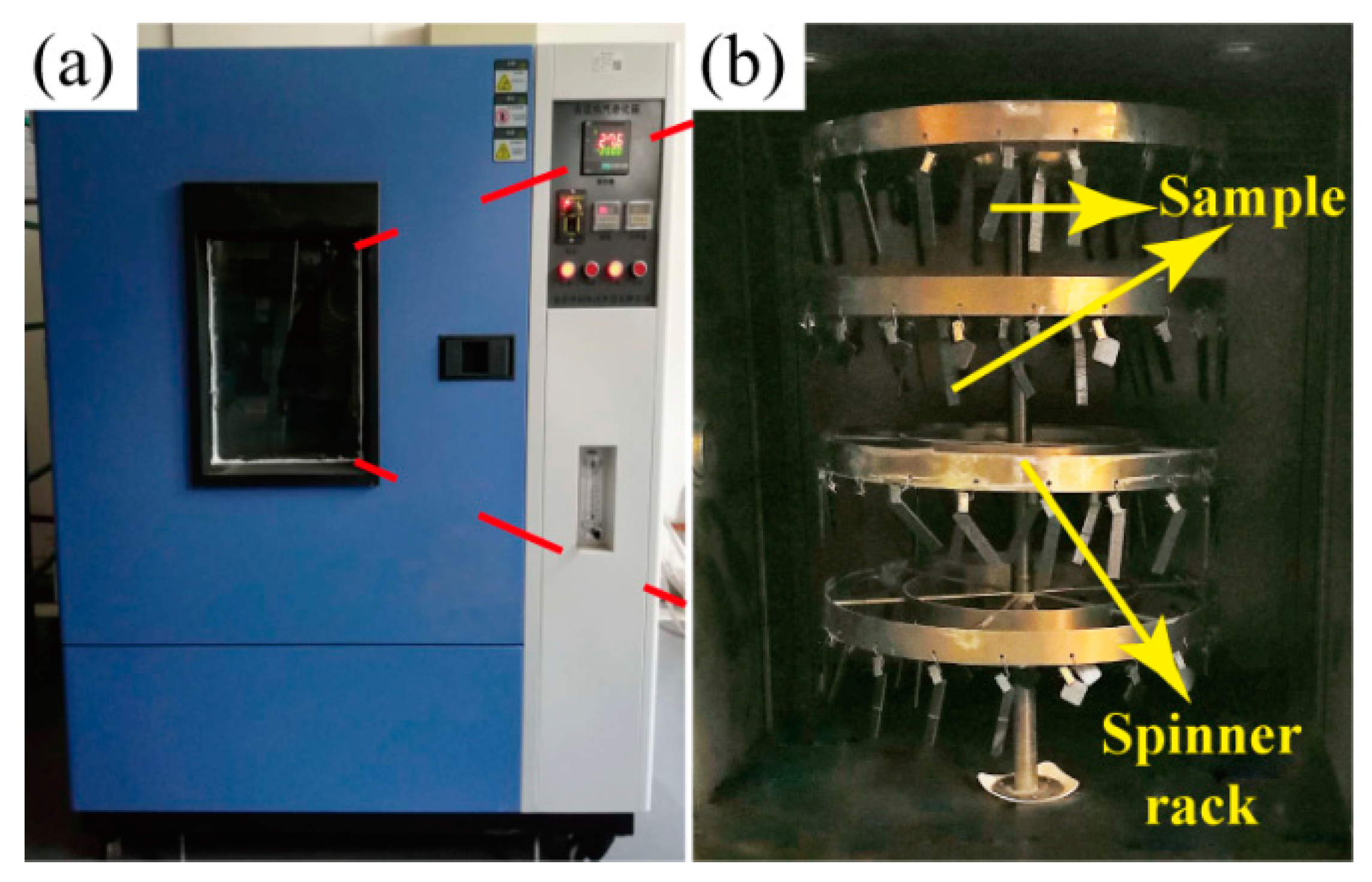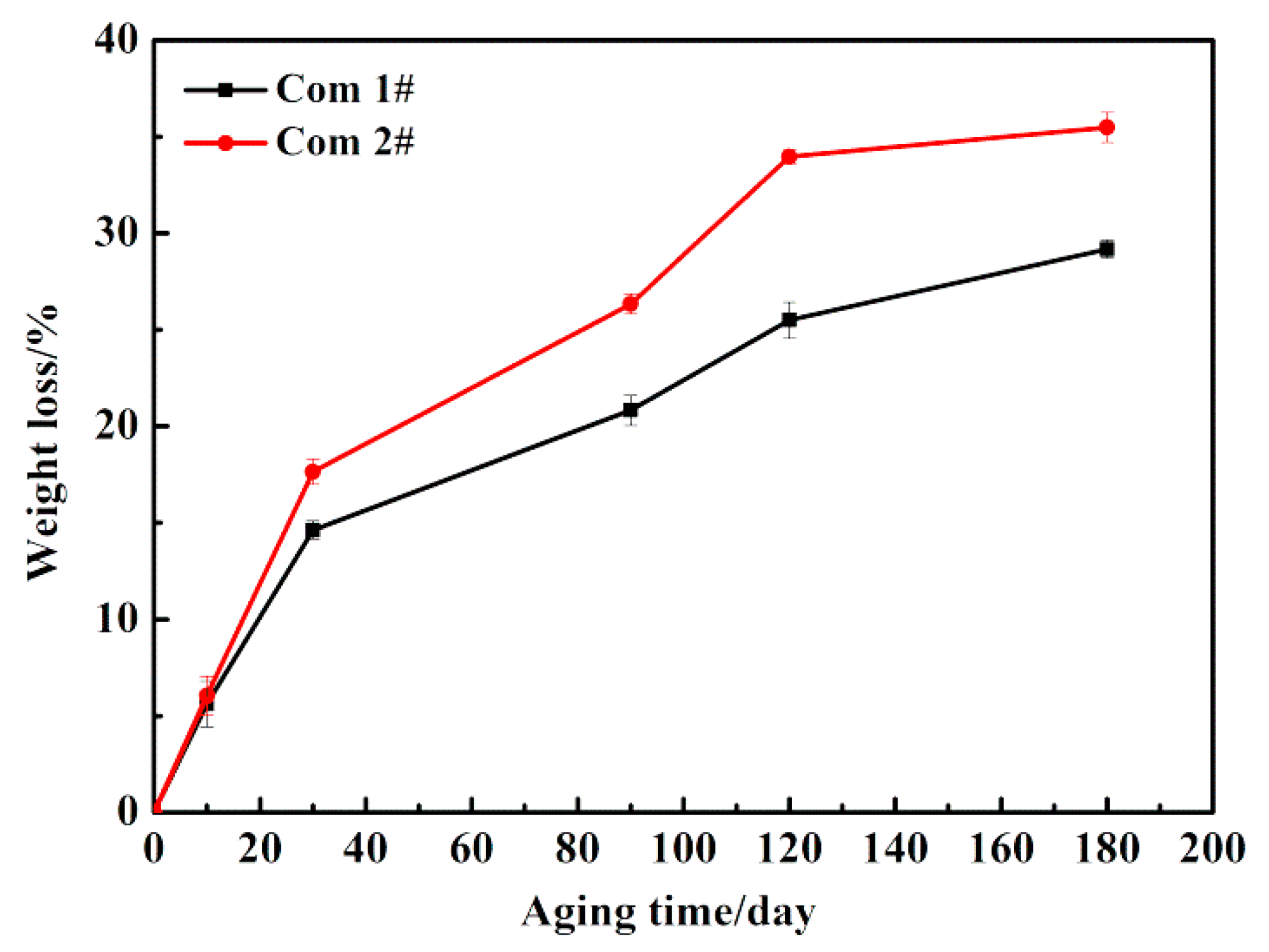Influence of Reinforcement Structures and Hybrid Types on Inter-Laminar Shear Performance of Carbon-Glass Hybrid Fibers/Bismaleimide Composites under Long-Term Thermo-Oxidative Aging
Abstract
:1. Introduction
2. Experimental Procedure
2.1. Materials
2.2. Thermo-Oxidative Aging
2.3. Test Methods
2.3.1. Fourier Transform Infrared (FTIR) Spectroscopy
2.3.2. Mass Loss
2.3.3. Inter-Laminar Shear Strength Testing
2.3.4. Morphology Characterization
3. Results and Discussion
3.1. Effects of TOA on Chemical Structures of BMI Resin
3.2. Effects of TOA on Mass Loss
3.3. Effects of Hybrid Structures on the Inter-Laminar Shear Property
3.4. Effects of Hybrid Types on Inter-Laminar Shear Properties
4. Conclusions
- Long-term TOA resulted in progressive deterioration of the matrix resins and fiber/matrix interfaces, in the form of chain scissions, weight loss, and fiber/matrix debonding, which led to the dramatic decrease of ILSS of hybrid composites.
- The Com 1# showed a higher ILSS retention rate than those of the laminated orthogonal hybrid composites. Also, no delamination occurred in aged Com 1# unlike the aged laminated orthogonal hybrid composites. This was because the Z-binder yarns in the Com 1# can resist the inter-laminar shear load, even under the condition of TOA.
- The ILSS retention rate of the Com 2# (with the CFs as the intermediate layers) was higher than that of the Com 3# (with the GFs as the intermediate layers). This phenomenon can be explained by the result that the CFs/BMI interface adhesion was stronger than that of the GFs/BMI under the same TOA condition.
Supplementary Materials
Author Contributions
Funding
Conflicts of Interest
References
- Luo, Z.; Zhou, X.; Yu, J. Mechanical properties of SiC/SiC composites by PIP process with a new precursor at elevated temperature. Mater. Sci. Eng. A 2014, 607, 155–161. [Google Scholar] [CrossRef]
- Liu, J.; Xiang, L.; Kan, T. The effect of temperature on the bending properties and failure mechanism of composite truss core sandwich structures. Compos. Part A Appl. Sci. Manuf. 2015, 79, 146–154. [Google Scholar] [CrossRef]
- Yang, B.; Yue, Z.; Geng, X.; Wang, P. Temperature effects on transverse failure modes of carbon fiber/bismaleimides composites. J. Compos. Mater. 2016, 51, 261–272. [Google Scholar] [CrossRef]
- Sun, P.; Zhao, Y.; Luo, Y.; Sun, L. Effect of temperature and cyclic hygrothermal aging on the interlaminar shear strength of carbon fiber/bismaleimide (BMI) composite. Mater. Des. 2011, 32, 4341–4347. [Google Scholar] [CrossRef]
- Li, Y.; Li, W.; Tao, Y.; Shao, J.; Deng, Y.; Kou, H.; Zhang, X.; Chen, L. Theoretical model for the temperature dependent longitudinal tensile strength of unidirectional fiber reinforced polymer composites. Compos. Part B Eng. 2019, 161, 121–127. [Google Scholar] [CrossRef]
- Vu, D.Q.; Gigliotti, M.; Lafarie-Frenot, M.C. Experimental characterization of thermo-oxidation-induced shrinkage and damage in polymer–matrix composites. Compos. Part A Appl. Sci. Manuf. 2012, 43, 577–586. [Google Scholar] [CrossRef]
- Liu, X.; Wu, Z.; Wang, R.; Yan, J. Experimental Study of the Electrical Resistivity of Glass-Carbon/Epoxy Hybrid Composites. Polym. Polym. Compos. 2014, 22, 289–292. [Google Scholar] [CrossRef]
- Hussein, R.M.; Anandan, S.; Chandrashekhara, K. Anisotropic oxidation prediction using optimized weight loss behavior of bismaleimide composites. J. Mater. Sci. 2016, 51, 7236–7253. [Google Scholar] [CrossRef]
- Luo, H.; Lu, G.; Roy, S.; Lu, H. Characterization of the viscoelastic behavior of bismaleimide resin;before and after exposure to high temperatures. Mech. Time-Depend. Mater. 2013, 17, 369–399. [Google Scholar] [CrossRef]
- Leveque, D.; Schieffer, A.; Mavel, A.; Maire, J. Analysis of how thermal aging affects the long-term mechanical behavior and strength of polymer?matrix composites. Compos. Sci. Technol. 2005, 65, 395–401. [Google Scholar] [CrossRef]
- Kobayashi, Y.; Kobayashi, S. Effect of long-term high-temperature atmospheric exposure on damage progress and mechanical properties for carbon fiber/polycyanate 90° unidirectional composites. Adv. Compos. Mater. 2014, 24, 1–19. [Google Scholar] [CrossRef]
- Barjasteh, E.; Bosze, E.; Tsai, Y.; Nutt, S. Thermal aging of fiberglass/carbon-fiber hybrid composites. Compos. Part A Appl. Sci. Manuf. 2009, 40, 2038–2045. [Google Scholar] [CrossRef]
- Akay, M.; Spratt, G.; Meenan, B. The effects of long-term exposure to high temperatures on the ILSS and impact performance of carbon fibre reinforced bismaleimide. Compos. Sci. Technol. 2003, 63, 1053–1059. [Google Scholar] [CrossRef]
- Haque, M.H.; Upadhyaya, P.; Roy, S.; Ware, T.; Voit, W.; Lu, H. The changes in flexural properties and microstructures of carbon fiber bismaleimide composite after exposure to a high temperature. Compos. Struct. 2014, 108, 57–64. [Google Scholar] [CrossRef]
- Upadhyaya, P.; Roy, S.; Haque, M.H.; Lu, H. A novel numerical–experimental approach for predicting delamination in high temperature polymer matrix composites. Compos. Struct. 2013, 104, 118–124. [Google Scholar] [CrossRef]
- Shaoquan, W.; Shangli, D.; Yu, G.; Yungang, S. Thermal ageing effects on mechanical properties and barely visible impact damage behavior of a carbon fiber reinforced bismaleimide composite. Mater. Des. 2017, 115, 213–223. [Google Scholar] [CrossRef]
- Lv, X.Y.; Wang, R.G.; Liu, W.B.; Jiang, L. Effect of Thermal-Oxidative Aging on the Mechanical Properties of Carbon Fiber Reinforced Bis-Maleimide Composites. Adv. Mater. Res. 2011, 152–153, 829–833. [Google Scholar] [CrossRef]
- Zhang, M.; Zuo, C.; Sun, B.; Gu, B. Thermal ageing degradation mechanisms on compressive behavior of 3-D braided composites in experimental and numerical study. Compos. Struct. 2016, 140, 180–191. [Google Scholar] [CrossRef] [Green Version]
- Kobayashi, Y.; Kobayashi, S. Experimental characterization of damage behavior in polycyanate CFRP laminates under high temperature atmospheric exposure. Adv. Compos. Mater. 2014, 25, 1–23. [Google Scholar] [CrossRef]
- Fan, W.; Li, D.-D.; Li, J.-L.; Li, J.-Z.; Yuan, L.-J.; Xue, L.-L.; Sun, R.-J.; Meng, J.-G. Electromagnetic properties of three-dimensional woven carbon fiber fabric/epoxy composite. Text. Res. J. 2017, 88, 2353–2361. [Google Scholar] [CrossRef]
- Zhang, D.; Waas, A.M.; Yen, C.-F. Progressive damage and failure response of hybrid 3D textile composites subjected to flexural loading, part I: Experimental studies. Int. J. Solids Struct. 2015, 75, 309–320. [Google Scholar] [CrossRef]
- Burks, B.; Kumosa, M. The effects of atmospheric aging on a hybrid polymer matrix composite. Compos. Sci. Technol. 2012, 72, 1803–1811. [Google Scholar] [CrossRef]
- Yang, B.; Tang, X.; Yang, K.; Xuan, F.-Z.; Xiang, Y.; He, L.; Sha, J. Temperature effect on graphene-filled interface between glass-carbon hybrid fibers and epoxy resin characterized by fiber-bundle pull-out test. J. Appl. Polym. Sci. 2018, 135, 46263. [Google Scholar] [CrossRef]
- Fan, W.; Xue, L.; Wei, T.; Dong, J.; Li, J.; Yuan, L.J.; Dang, W.; Sun, R.; Chen, X. Enhancement of mechanical and electromagnetic absorbing properties of carbon/glass hybrid composites with a three-dimensional quasi-isotropic braided structure. Text. Res. J. 2019. [Google Scholar] [CrossRef]
- Glaskova-Kuzmina, T.; Aniskevich, A.; Martone, A.; Giordano, M.; Zarrelli, M. Effect of moisture on elastic and viscoelastic properties of epoxy and epoxy-based carbon fibre reinforced plastic filled with multiwall carbon nanotubes. Compos. Part A Appl. Sci. Manuf. 2016, 90, 522–527. [Google Scholar] [CrossRef]
- Fan, W.; Yuan, L.; D’Souza, N.; Xu, B.; Dang, W.; Xue, L.; Li, J.; Tonoy, C.; Sun, R. Enhanced mechanical and radar absorbing properties of carbon/glass fiber hybrid composites with unique 3D orthogonal structure. Polym. Test. 2018, 69, 71–79. [Google Scholar] [CrossRef]
- Mahmood, M.S.; Larry, B.L. An Assessment of the Double-Notch Shear Test for Interlaminar Shear Characterization of a Unidirectional Graphite/Epoxy under Static and Fatigue Loading. Appl. Compos. Mater. 1998, 5, 49–64. [Google Scholar]
- Lv, X.; Wang, R.; Liu, W.; Jiang, L. Effect of thermal-oxidative aging on carbon fibre-bismaleimide composites. Pigment. Resin Technol. 2012, 41, 34–41. [Google Scholar] [CrossRef]
- Dao, B.; Hodgkin, J.; Krstina, J.; Mardel, J.; Tian, W. Accelerated ageing versus realistic ageing in aerospace composite materials. III. The chemistry of thermal ageing in bismaleimide based composites. J. Appl. Polym. Sci. 2007, 105, 2062–2072. [Google Scholar] [CrossRef]
- Akay, M.; Spratt, G.R. Evaluation of thermal ageing of a carbon fiber reinforced bismalemide. Compos. Sci. Technol. 2008, 68, 3081–3086. [Google Scholar] [CrossRef]
- Fan, W.; Li, J.-L.; Zheng, Y.; Guo, D. The effect of reinforced structure on thermo-oxidative stability of polymer-matrix composites. J. Ind. Text. 2015, 46, 237–255. [Google Scholar] [CrossRef]
- Li, D.; Fang, D.; Zhang, G.; Hu, H. Effect of temperature on bending properties and failure mechanism of three-dimensional braided composite. Mater. Des. 2012, 41, 167–170. [Google Scholar] [CrossRef]









| Reinforced Structure | Unit Density/(yarn/cm) | Layers | Fiber Volume Fraction | ||
|---|---|---|---|---|---|
| Warp | Weft | Z-Binder Yarn | |||
| 3D orthogonal woven hybrid preform | 5 | 5 | 5 | 13 | 57.24% |
| Laminated orthogonal hybrid preform | 5 | 5 | - | 11 | 55.26% |
| Peaks Position (cm−1) | Assignment | Functional Group |
|---|---|---|
| 3054 | Water, non-bonded hydroxyl | –OH |
| 2929 | Asymmetric CH2 stretch | –CH2– |
| 2845 | Symmetric CH3 | –CH3 |
| 1710 | Asymmetric imide | –C=O |
| 1602 | C=C stretch with C=O conjugation | –C=C–C=O |
| 1260 | Various carbon-oxygen | –C–O– |
| 1098 | Succinimide or ether | C–N–C, –C–O–C– |
| 934 | Maleimide deformation | C=C |
© 2019 by the authors. Licensee MDPI, Basel, Switzerland. This article is an open access article distributed under the terms and conditions of the Creative Commons Attribution (CC BY) license (http://creativecommons.org/licenses/by/4.0/).
Share and Cite
Li, J.; Fan, W.; Ma, Y.; Xue, L.; Yuan, L.; Dang, W.; Meng, J. Influence of Reinforcement Structures and Hybrid Types on Inter-Laminar Shear Performance of Carbon-Glass Hybrid Fibers/Bismaleimide Composites under Long-Term Thermo-Oxidative Aging. Polymers 2019, 11, 1288. https://doi.org/10.3390/polym11081288
Li J, Fan W, Ma Y, Xue L, Yuan L, Dang W, Meng J. Influence of Reinforcement Structures and Hybrid Types on Inter-Laminar Shear Performance of Carbon-Glass Hybrid Fibers/Bismaleimide Composites under Long-Term Thermo-Oxidative Aging. Polymers. 2019; 11(8):1288. https://doi.org/10.3390/polym11081288
Chicago/Turabian StyleLi, Juanzi, Wei Fan, Yanli Ma, Lili Xue, Linjia Yuan, Wensheng Dang, and Jiaguang Meng. 2019. "Influence of Reinforcement Structures and Hybrid Types on Inter-Laminar Shear Performance of Carbon-Glass Hybrid Fibers/Bismaleimide Composites under Long-Term Thermo-Oxidative Aging" Polymers 11, no. 8: 1288. https://doi.org/10.3390/polym11081288





